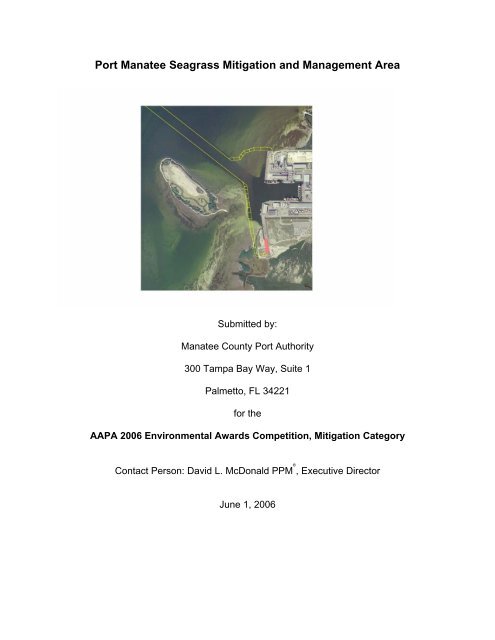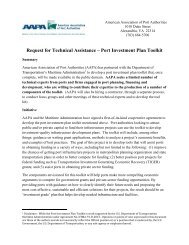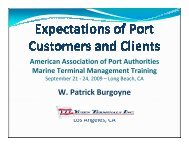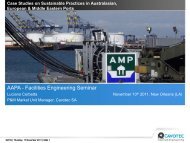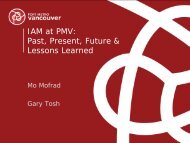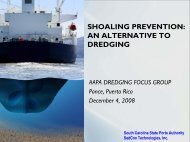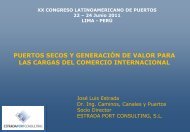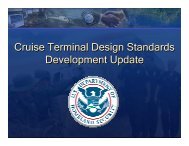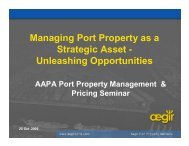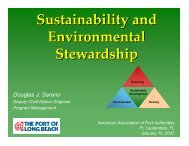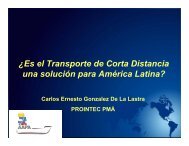Port Manatee Seagrass Mitigation and Management Area
Port Manatee Seagrass Mitigation and Management Area
Port Manatee Seagrass Mitigation and Management Area
Create successful ePaper yourself
Turn your PDF publications into a flip-book with our unique Google optimized e-Paper software.
1.0 INTRODUCTION<strong>Manatee</strong> County <strong>Port</strong> Authority (MCPA) has embarked on an ambitious expansion of<strong>Port</strong> <strong>Manatee</strong> that involves construction of 2,700 feet of new ship berths <strong>and</strong> a turningbasin. The project involves the dredging of some 5 million cubic yards of material over100 acres. The project involves unavoidable but minimized impacts to mangroves,shallow bay bottom, <strong>and</strong> 5.53 acres of seagrasses. The <strong>Port</strong> Authority adopted anecosystem design approach to the mitigation of the impacts. The Department ofEnvironmental Protection (DEP) <strong>and</strong> the U.S. Army Corps of Engineers (ACOE)authorized the <strong>Manatee</strong> County <strong>Port</strong> Authority’s long-range navigation <strong>and</strong> berthimprovements program <strong>and</strong> agreed with the proposed improvements <strong>and</strong> theimplementation of a multi-facetted seagrass mitigation program. The program proposedby the <strong>Port</strong> Authority <strong>and</strong> approved by the environmental agencies combines severalenhancements into a program that will provide a substantial net benefit to the localecosystem <strong>and</strong> economy. The entire program has been constructed <strong>and</strong> has been verysuccessful.In implementing the plan, the <strong>Port</strong> Authority used 90 acres ofenvironmentally sensitive l<strong>and</strong> purchased for enhancement <strong>and</strong> preservation. The firstpart of the plan was to mitigate the removal of the seagrass beds <strong>and</strong> the reduction ofthe aquatic habitat by transplanting 5.33 acres of seagrass located within the proposedturning basin <strong>and</strong> new berth construction impact sites. <strong>Seagrass</strong>es in the impact areaswere transplanted prior to dredging. The mitigation plan has created over 20 acres ofnew successful seagrass meadows at densities comparable to natural meadows. Themitigation plan also included establishing a 480-acre Motorized Vessel Restriction Zone3
local ecosystem. Environmental agencies, environmental professionals <strong>and</strong> interestgroups were consulted regarding ecosystem needs <strong>and</strong> opportunities. Though therestoration plans provided an improved bird habitat, the <strong>Port</strong> expansion does not impactthese types of habitat.> Goal: Provide education opportunities, environmental improvement <strong>and</strong> recognizablebenefit to the communityObjective: Creating a bird nesting area <strong>and</strong> building a community facility that includes aboat ramp, a park, <strong>and</strong> an educational facility to educate people as to theirenvironmental responsibility. The more public appeal that an environmentalimprovement project has, the more valuable a tool it is for demonstrating <strong>and</strong> fosteringenvironmental stewardship in the community. This factored into the seagrass mitigationprogram with the creation of a bird habitat <strong>and</strong> the reconstructing of the boat launch <strong>and</strong>associated park.Methodology<strong>Seagrass</strong> mitigation activities were initiated on July 2001 <strong>and</strong> consisted of transplantingthe 5.33 acres of seagrasses from the impact areas, to mitigation sites 1-7. Anadditional 1.92 acres of seagrass was transplanted from the three flushing channelsassociated with construction of <strong>Mitigation</strong> Site 7 to <strong>Mitigation</strong> Sites 4 <strong>and</strong> 6. Followingthis event, small areas of incidental seagrass re-growth from the Berth 12 permit impactsites were transplanted into mitigation site 7 with approval from DEP. All initialtransplanting activities were completed by January 2002. Refer to Figure 1-1 depictingthe location of the mitigation sites <strong>and</strong> the MVRZ.Following the completion of these activities, the MCPA submitted the First AnnualProgress <strong>and</strong> <strong>Mitigation</strong> Success Report on December 31, 2002 to DEP pursuant tospecific condition of the permit as well as the monitoring requirements described in the<strong>Seagrass</strong> <strong>Mitigation</strong> Plan appended to the permit. In the <strong>Mitigation</strong> Success Report, theMCPA provided documentation that 10 acres of seagrass coverage, equating to 8 acresof dredging success by the permit formulas had been achieved. In conjunction with thisreport, the MCPA requested a determination of seagrass mitigation success, particularly8
in regards to achieving specific conditions of the permit related to dredgingauthorization. Confirmation for authorization of “dredging success” was obtained fromthe DEP <strong>and</strong> COE in January 2003, indicating that at least 5.66 acres (>105% of the5.33 acres impacted) of seagrass success had been achieved.<strong>Seagrass</strong> mitigation success monitoring for year 2 was initiated on September21, 2003 <strong>and</strong> completed on December 4, 2003 under the supervision of the seagrassmitigation supervisor, Scheda Ecological Associates, Inc. (SEA). The 2003 monitoringresults <strong>and</strong> data analysis, along with a request for a determination of interim seagrassmitigation success credit was summarized in the 2003 <strong>Seagrass</strong> <strong>Mitigation</strong>Credit/Success Confirmation Report prepared by Environmental Audit & Compliance,Inc. (EAC) <strong>and</strong> submitted to DEP <strong>and</strong> the ACOE on January 26, 2003. The subsequentSecond Annual Progress Report was later prepared <strong>and</strong> submitted by SEA on May 6,2004. The monitoring protocol utilized to produce the results summarized in the 2003submittals were consistent with the permits of the previously submitted Report Claim forDredging Authorization, <strong>and</strong> agreements made with the DEP in 2002 <strong>and</strong> 2003.Following the submittal of these reports, meetings were held with the DEP todiscuss the 2003 results <strong>and</strong> to confirm the MCPA’s determination of mitigationsuccess/ credit achieved. As of September 2004, a consensus had not been reachedbetween the DEP <strong>and</strong> the MCPA regarding a formal determination <strong>and</strong>/or approval ofthe requested mitigation credits. However, in accordance with agreements madebetween the DEP <strong>and</strong> the MCPA during the January 28, 2005 meeting, the data <strong>and</strong>subsequent analyses submitted as part of the 2003 Second Annual Progress Report<strong>and</strong> the Credit/Success Confirmation Report have been re-assessed <strong>and</strong> combined withthe 2004 monitoring results to form the Third Annual Progress <strong>and</strong> <strong>Mitigation</strong>Success/Credit Confirmation Report.The consolidated report represented a post-three year assessment of the MCPAseagrass mitigation project <strong>and</strong> summarized the results of the 2003-2004 monitoringefforts, including the MCPA’s request for mitigation success/credit determination.Subsequent to the submittal of the consolidated report on March 4, 2005, the DEP9
granted approval of 60% of the total mitigation credits requested. This represents apost-four year assessment of the MCPA seagrass mitigation project <strong>and</strong> summarizedresults of the 2005 monitoring efforts.The mitigation plan also included establishing a 480-acre Motorized VesselRestriction Zone (MVRZ) for the perpetual protection of the seagrasses <strong>and</strong> the WestIndian <strong>Manatee</strong>. The goal of the Motorized Vessel Restriction Zone (MVRZ) is toenhance the quality of the local ecosystem by protecting manatees <strong>and</strong> seagrasses.The endangered, indigenous manatee is vulnerable to injury <strong>and</strong> death by the propellersof fast moving internal combustion engine-powered boats, especially in shallow waterwhere it is difficult for the manatee to escape. <strong>Seagrass</strong> is a vital component of theecological health of Tampa Bay as a fish nursery, a habitat, <strong>and</strong> a food source for sealife. It is a resource that is depleted as a result of prop scarring by internal combustionengine-powered boats running in the shallow waters of the management area. Theobjective of the management area is to protect manatees <strong>and</strong> seagrasses by eliminatingthe threat of internal combustion engines.4.0 AWARD CRITERIAA. Benefits to Environmental Quality, Beautification <strong>and</strong> Community Involvement<strong>Seagrass</strong> is a vital component of the ecological health of Tampa Bay as a fish nursery,a habitat, <strong>and</strong> food source for marine life. In terms of benefits to environmental quality,the restoration of the 5.33 acres of seagrass with the addition of 20 acres to theseagrass to the Tampa Bay inventory is resulting in greater aquatic habitat. Ongoingmanagement involves patrolling <strong>and</strong> policing the established a 480-acre MotorizedVessel Restriction Zone (MVRZ) for the perpetual protection of the seagrasses <strong>and</strong> theWest Indian <strong>Manatee</strong>, two vital components of the ecosystem, in an area where theyare particularly vulnerable.Beautification is coming in the form of seagrass growth assisting in the expansion of the10
fish population <strong>and</strong> the return of rare birds to a habitat created for their continued safety<strong>and</strong> population growth.Community involvement is coming through environmental education. Through thisproject the <strong>Port</strong> is restoring the public boat ramp on acquired property <strong>and</strong> developing anew park associated with the boat launch facility. The boat ramp <strong>and</strong> l<strong>and</strong>side park willprovide a family environment <strong>and</strong> a venue for presenting public educational informationstressing the value of the local environment <strong>and</strong> educating the families using the facilityon the wonders of nature <strong>and</strong> the importance of environmental stewardship.B. Independent Involvement <strong>and</strong> Effort by the <strong>Port</strong><strong>Port</strong> staff were integral to the development of the ecosystem approach, development ofthe project concept, acquisition of Audubon involvement, development <strong>and</strong> negotiationof the mitigation plan <strong>and</strong> the permit authorizations, conceptual design of the project,securing of contractual arrangements <strong>and</strong> the ongoing management of the seagrassbed. Each aspect has involved either <strong>Port</strong> staff performance or <strong>Port</strong> staff direction of theperformance of technical consultants. The <strong>Port</strong> Authority solely <strong>and</strong> independentlyproposed the prohibition of internal combustion engines, affected passage of theordinance, purchased l<strong>and</strong> within the management area for construction <strong>and</strong> operationof the boat ramp with educational facilities, purchased <strong>and</strong> installed the boundarymarkers, monitor <strong>and</strong> maintain the buoys marking the seagrass beds <strong>and</strong> finances <strong>and</strong>operates the patrolling of the Motorized Vessel Restriction Zone (MVRZ).C. Creativity of the SolutionThe <strong>Port</strong> <strong>Manatee</strong> <strong>Seagrass</strong> <strong>Mitigation</strong> Project was creative from a number ofdifferent perspectives: The project was born out of an ecosystem approach tomitigation design <strong>and</strong> was used to maximize the benefit to the local ecosystemresulting in new <strong>and</strong> increased habitats. Improvement <strong>and</strong> expansion needs were11
combined with public relations <strong>and</strong> a public education program through therefurbishment of the public boat ramp, <strong>and</strong> the construction of a park at the boatlaunch facility. The program is extremely creative in that it is designed formaximum effectiveness by utilizing the principles of human nature wherebypeople absorb information from their environment <strong>and</strong> subconsciously alter theirmisconceptions about their environment.D. Project ResultsThe project is still in progress <strong>and</strong> has already proven successful. We are currently halfway through the dredging project <strong>and</strong> completed transplanting over 5 acres of seagrass,added more than 20 acres of seagrass achieving a mitigation ratio of better than 4:1,established the Motorized Vessel Restriction Zone (MVRZ) <strong>and</strong> the internal combustionengine prohibition ordinance has been passed. Boundary markers have been installed.The management plan is in operation, including patrolling of the area. <strong>Management</strong> ofthe area has already resulted in a significant increase in seagrass coverage due torecovery of seagrass within previous prop scar areas. Documentation of mitigationmonitoring <strong>and</strong> quantifying improvements are currently being reviewed by theenvironmental agencies.E. Cost EffectivenessDevelopment costs are effectively higher than the costs of the transplant method butarranging for credit for prop scar recovery in protected areas eliminates the plantingcost. This program is cost-effective <strong>and</strong> takes advantage of natural seagrass expansionto achieve mitigation goals. By heavy patrolling <strong>and</strong> working to minimize seagrass beddamage from prop scaring, it is much less expensive to eliminate impacts to seagrassesallowing nature to h<strong>and</strong>le the recovery, than it is to transplant seagrasses or develop12
new seagrass beds. The cost effectiveness of the improvements to the communityfacilities are as yet unmeasured, but with one local area boat launch scheduled to beclosed by the county <strong>and</strong> the only other local public facility overburdened, it is felt thatthe community will greatly appreciate the refurbished <strong>and</strong> exp<strong>and</strong>ed facility <strong>and</strong> itsenvironmental education venue will be invaluable to the environmental stewardship inthe area.F. Transferability of the Idea to the <strong>Port</strong> IndustryThe concept of this project is transferable to the <strong>Port</strong> industry in very important ways:The ecosystem approach to mitigation design is viable in terms of mitigation value. Theproximity of a mitigation site to impact areas so often is an important consideration inmitigation valuation. This concept is particularly valuable to <strong>Port</strong>s with limitedopportunities for in-kind mitigation on site. The principle of managing an area forprotection of natural resources is applicable anywhere there are natural resources thatneed to be protected. Other <strong>Port</strong>s conducting similar permitting can cite proof ofseagrass mitigation success. Convincing environmental agencies that it can be done onthis large a scale is half the battle. The following formula is simple enough to beadapted to many other situations: identify the cause of environmental impact, utilize <strong>Port</strong>influence to eliminate the cause of the impact <strong>and</strong> to protect the natural resource, obtainenvironmental credit for the work, <strong>and</strong> provide a community asset that can producegoodwill <strong>and</strong> subtle environmental education.5.0 CONCLUSIONThe <strong>Port</strong> <strong>Manatee</strong> <strong>Seagrass</strong> <strong>Mitigation</strong> Project has provided a number of invaluablebenefits. The project has fulfilled a major part of the mitigation requirements for <strong>Port</strong>expansion; it has filled an important need in the Tampa Bay ecosystem; it hasdemonstrated the <strong>Port</strong>’s commitment to environmental stewardship; it has provided13
assets <strong>and</strong> services back to the community <strong>and</strong> it illustrates opportunities for other<strong>Port</strong>s. The impact of this type of program to prevent losses of natural resources is fargreater than the impact of spending the same amount of money on creation of newenvironmental resources. Highlighting the benefits of <strong>Port</strong> <strong>Manatee</strong>’s <strong>Seagrass</strong>mitigation program with an environmental award is an excellent way to show other <strong>Port</strong>show they can achieve substantial environmental benefits while at the same timemeeting their need to exp<strong>and</strong> <strong>and</strong> increase their productivity.14


